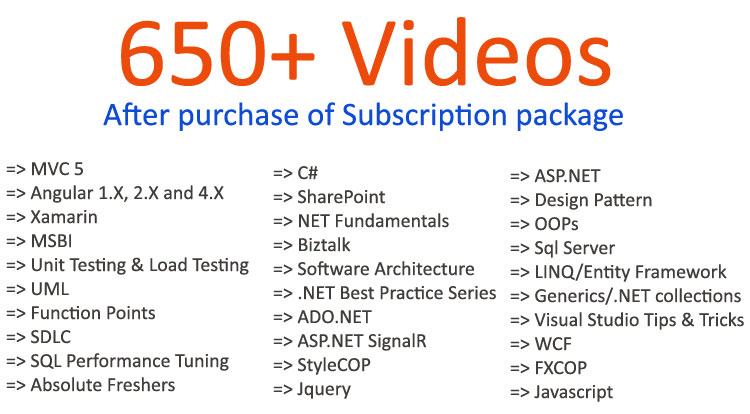Angular 6 tutorial for beginners
| Chapters | Chapters |
| Chapter 1 :- Node and NPM Chapter 2 :- Running first app & Angulr CLI Chapter 3 :- VS Code editor. Chapter 4 :- TypeScript Chapter 5 :- CLI project folder structure Chapter 6 :- The config JSON files Chapter 7 :- ng serve vs ng build Chapter 8 :- Angular the binding framework Chapter 9 :- Component and Modules Chapter 10 :- Expression , Decorators and TemplateURL Chapter 11 :- Declaration and BootStrap in Modules Chapter 12 :- The main.ts file for module startup Chapter 13 :- Index.html and the selector tag Chapter 14 :- Polyfills Chapter 15 :- Webpack :- Packaging and deploying Chapter 16 :- Vendor.js and Runtime.js Chapter 17 :- Angular File naming Convention Chapter 18 :- Creating Customer UI Chapter 19 :- Creating Customer Model Chapter 20 :- Consuming model in component Chapter 21 :- ngModel , One way and Two way binding Chapter 22 :- Expressions Chapter 23 :- Understanding and Intrepeting Errors Chapter 24 :- FormsModule Chapter 25 :- *ngForLoop Chapter 26 :- package.lock.json and versioning Chapter 27 :- Using source code of the tutorial. Chapter 28 :- Thinking Uniform , Thinking Master Pages Chapter 29:- Creating Angular UI and its components. Chapter 30 :- Organizing project folders, modules & components. Chapter 31 :- Masterpage and selector Chapter 32 :- Grouping components in to Modules. Chapter 33 :- Understanding UI loading in selector. Chapter 34 :- Routing and Routing collection Chapter 35 :- router-outlet and routerLink Chapter 36 :- RouterModule and loading routes in Angular. Chapter 37 :- Understanding the flow of Angular with routing. Chapter 38 :- Performance issues due to eager loading. Chapter 39 :- Implementing Lazy loading Chapter 40 :- Dividing project in to self contained Angular modules. Chapter 41 :- Self contained routes for self contained modules. Chapter 42 :- loadChildren :- The heart of lazy loading Chapter 43:- Understanding path structure for folders and loadChildren. Chapter 44:- forRoot and forChild Chapter 45:- Multiple Modules , Multiple builds and Multiple outputs. Chapter 46:- CommonModule for Lazy Loading Chapter 47:- Seeing the physical separate modules in the "dist" folder. | Chapter 48:- Revising Angular architecture with Lazy routing Chapter 49 :- Validation object model. Chapter 50 :- Appropriate place to put validations Chapter 51 :-Formgroup , FormControl , Validators and FormBuilder Chapter 52 :- Using Angular validation :- The CCC process. Chapter 53 :- Creating validations Chapter 54 :- Applying validations to the UI Chapter 55 :- Checking validation status Chapter 56 :- ReactiveForms Chapter 57 :- ngModelOption standalone Chapter 58 :- Display errors for individual validations. Chapter 59 :- The dirty flag. Chapter 60 :- Centralizing validation code for reusability. Chapter 61: - Definition of a good architecture Chapter 62: - Concrete classes and tight coupling Chapter 63: - Provider - provides things to component. Chapter 64: - Creating providers: - Provide & UseClass Chapter 65: - Interfaces issues with Angular DI Chapter 66: - Finally understanding Dependency Injection Chapter 67: - Seeing the actual fruits of Dependency Injection Chapter 68: - Centralized and Conditional DI Chapter 69: - Injector and tokens - Conditionnal DI Chapter 70: - Dynamic collections Chapter 71: - Revising Angular DI architecture Chapter 72 :- Defining a user control Chapter 73 :- Interactions :- Input, output and event emitters Chapter 74 :- Creating user control and its components Chapter 75 :- Creating user control component and importance of selector Chapter 76 :- The @input decorator Chapter 77 :- Stters and custom component naming convention Chapter 78 :- Creating the Grid UI of the user control Chapter 79 :- Defining output and event emitters Chapter 80 :- Understanding the user control flow Chapter 81 :- Importing and running the user control Chapter 82 :- Debugging and watching the full flow. Chapter 83 :- Json-server , the fake webserver Chapter 84 :- Configuring json-server & db.json. Chapter 85 :- importing and creating http component object Chapter 86:- Making HTTP Post calls and the subscribe method. Chapter 87 :- Import HTTP Module at the module level. Chapter 88 :- Implementing DTO( Data transfer objects) Chapter 89 :- Lambdas and Callback Chapter 90 :- Angular HTTP Client. Chapter 91 :- Using HttpClient Chapter 92 : Simplicity of HttpClient. Chapter 93:- Interceptors in HttpClient Chapter 94:- The double data post |




